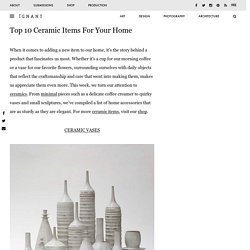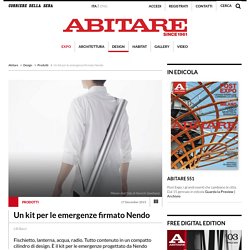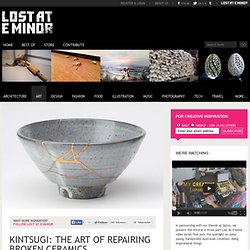

Top 10 Ceramic Items For Your Home – iGNANT.de. When it comes to adding a new item to our home, it’s the story behind a product that fascinates us most.

Whether it’s a cup for our morning coffee or a vase for our favorite flowers, surrounding ourselves with daily objects that reflect the craftsmanship and care that went into making them, makes us appreciate them even more. This week, we turn our attention to ceramics. From minimal pieces such as a delicate coffee creamer to quirky vases and small sculptures, we’ve compiled a list of home accessories that are as sturdy as they are elegant. For more ceramic items, visit our shop.
Offering a total of 15 ceramic vases, this grand collection serves as a household statement. According to the designer, these porcelain plates were originally created for serving desserts. Made from white stoneware clay in an oatmeal shade, this small ceramic mortar makes a nice addition to your kitchen, if you want to try your hand at making your own pesto or chutney. Un kit per le emergenze firmato Nendo.
Terremoti, alluvioni, epidemie, guerriglia urbana.

Le nostre città sono sempre più vulnerabili e soggette a eventi imprevedibili, che si tratti di catastrofi climatiche o di attacchi terroristici. Sul tema deve aver riflettuto lo studio Nendo, che ha appena presentato il progetto Minim+Aid, rifacendosi anche alla storia del Giappone (dove lo studio opera), che ha dovuto affrontare numerosi disastri naturali e dove ogni volta la popolazione ha resistito continuando a ricostruire le proprie comunità.
Così lo studio ha pensato di sviluppare un kit di emergenza versatile, utile per una varietà di situazioni, che include il minimo indispensabile al cittadino medio per sopravvivere nei casi in cui ci si trovi improvvisamente senza acqua, elettricità e connessioni. La radio è dotata di funzionalità di carica manuale, utilizzabile anche per ricaricare lo smartphone, la lanterna o altri dispositivi tramite USB. Facile da trasportare, Minim+Aid può essere indossato a tracolla. Mind-Bending Lamps By Studio Cheha. The designers behind Tel Aviv-based Studio Cheha create unique lamps that are optical illusions.

Made of acrylic glass, the lampshade is actually a 2D sheet that turns into a classic reading light silhouette when switched on. Studio Cheha surpassed their £15,000-Kickstarter goal in three days to fund a mass production of lamps. The studio's aim is to transform everyday objects into products that can offer a new way of experiencing space and form. All images © Studio Cheha. Kintsugi: the art of repairing broken ceramics. Did you know that in Japan, the act of repairing broken ceramics is an art form?

The 16th century ‘Kintsugi’, or ‘Kintsukuroi’, is a repairing technique that celebrates the broken item’s rich history by decorating its cracks instead of hiding them. This is done by applying a mixture of urushi (lacquer resin), rice glue, and powdered gold, silver, or platinum. No two Kintsugi patterns are the same, with each golden stream’s path depending on the extent and pattern of the break. The method gives the broken pottery piece new life and identity, making it good as new – sometimes better than the original, even. The video below was created by Greatcoat Films in London. Via This Is Colossal. How to Turn Wine Bottles into Tumblers. You knew you’d been saving all those wine bottles for a reason!

With this in-depth tutorial, we’re pumped to show you how to turn old wine bottles into gorgeous new tumblers. Not only are these green (both in color and in eco-ness), they make a great gift for the holidays and are an instant conversation piece. This tutorial is definitely on the more advanced end of the spectrum, and requires a few tools you may not be familiar with. As long as you follow the steps you can definitely make it happen, but feel free to shoot questions our way via the comments below or send an email to hello@brit.co. Materials: - wine bottles with parallel sides - bottle cutter (available on Amazon) - rags or towels - large pot + potholder - candle - 2-3 sheets of dry or wet sandpaper ranging from medium (~150) to fine (~300-400) - 1 sheet of craft-foam - safety mask & goggles (not necessary if using sandpaper) First thing to do is remove those labels. Now, it’s time to start cutting your bottle!